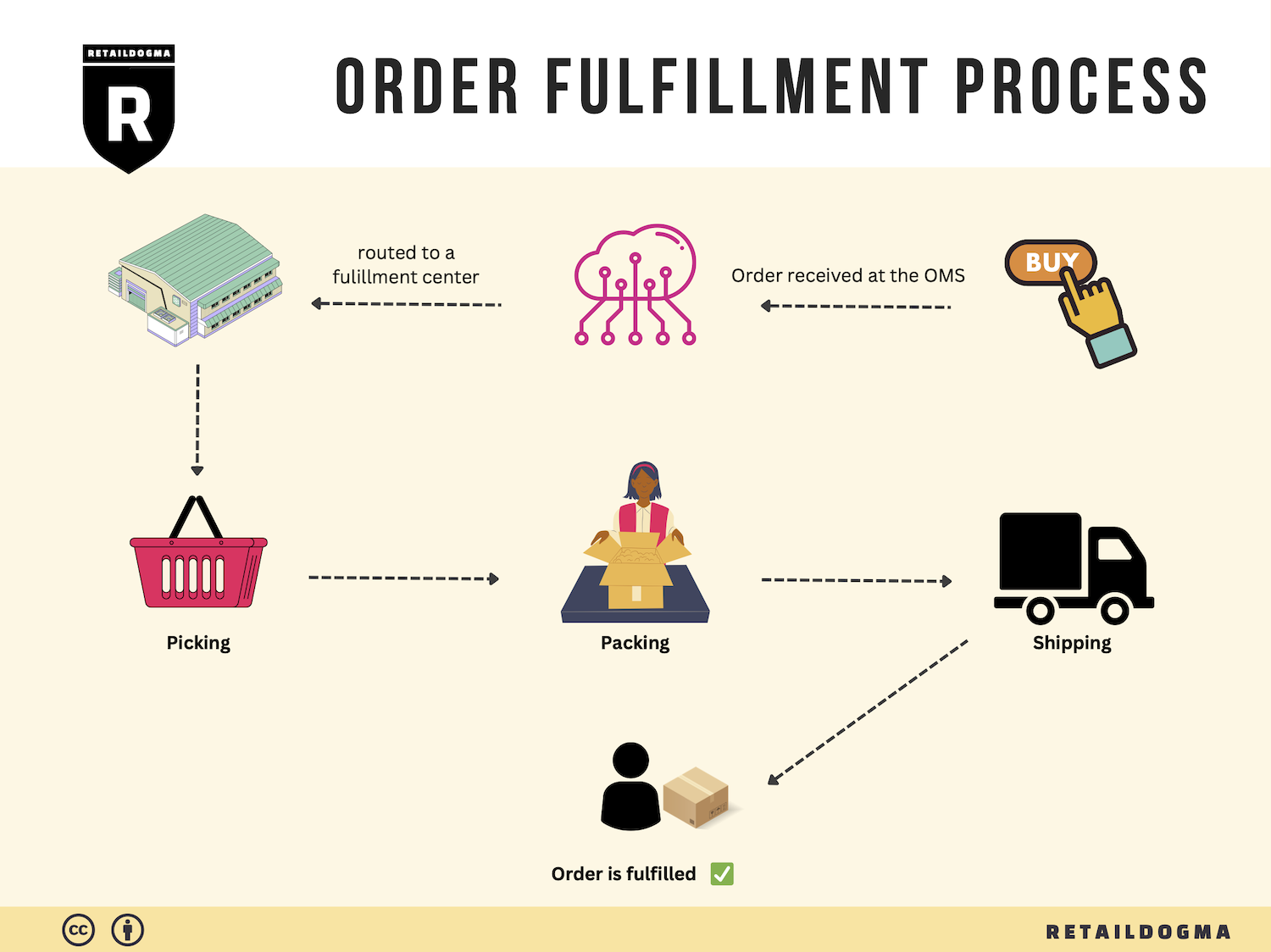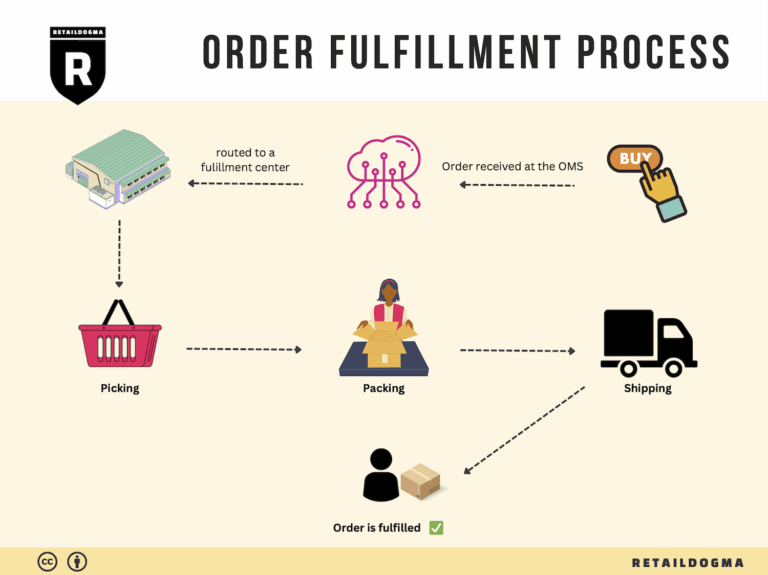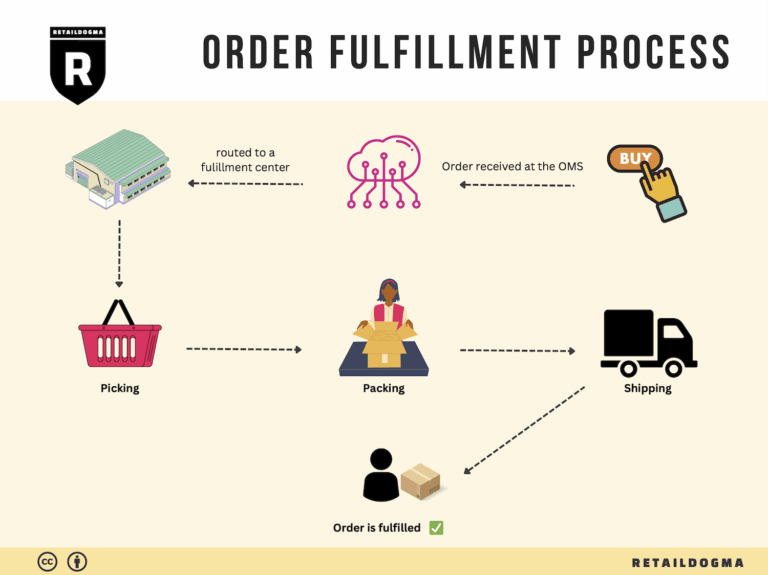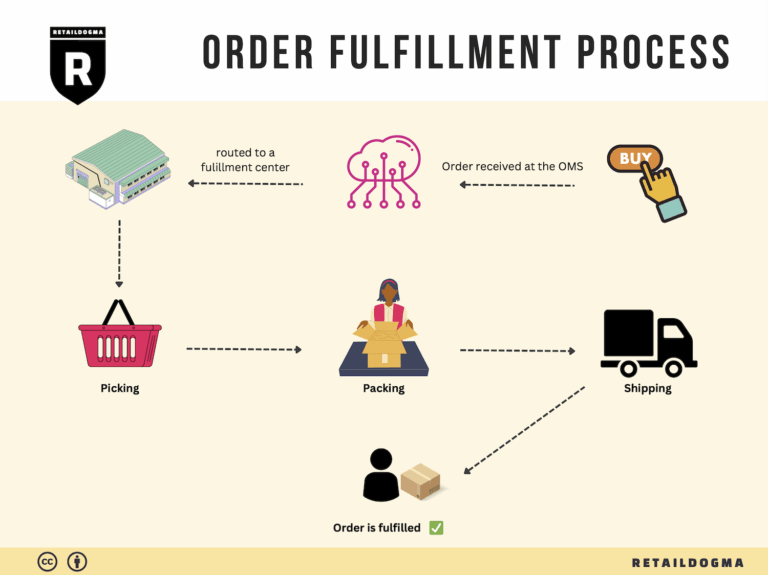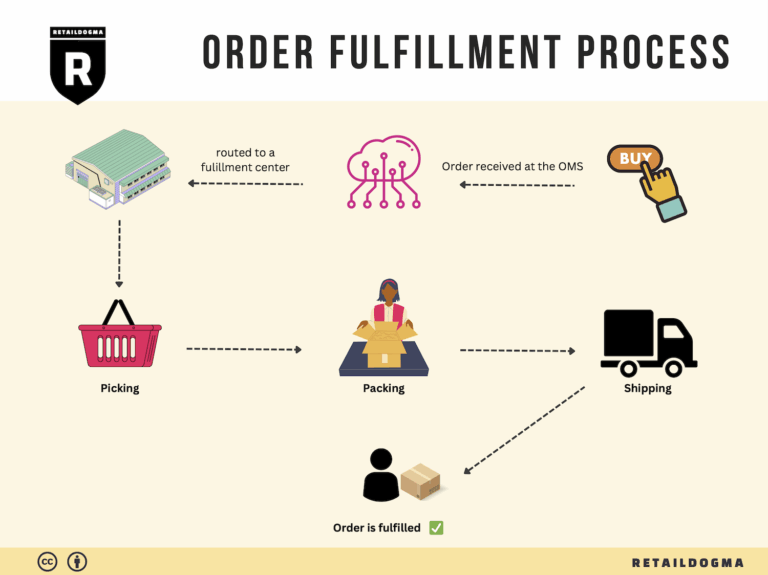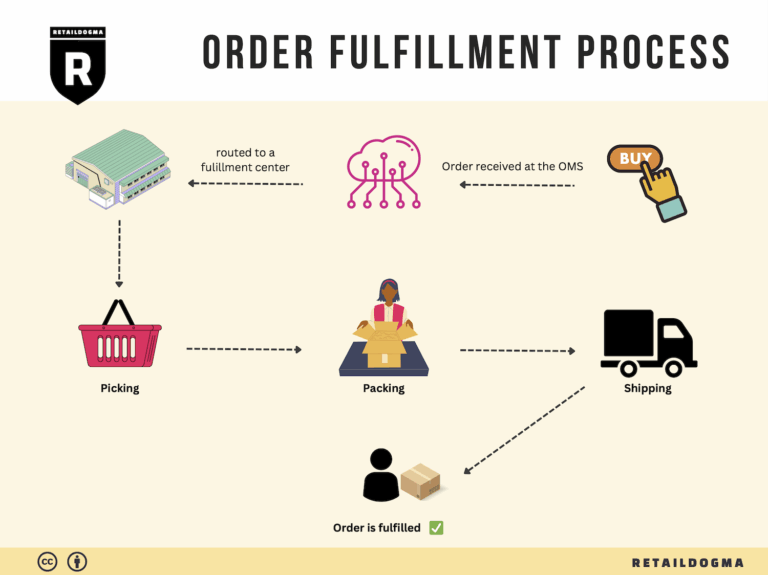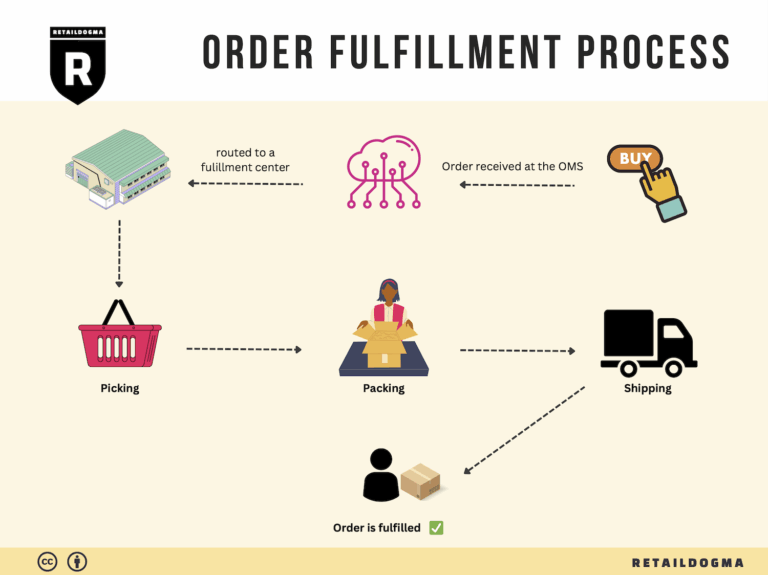What Is A Fulfillment Center? A Complete Guide (2025)
What is E-commerce Fulfillment? An Introduction for Growing Businesses
Understanding E-commerce Fulfillment: A Key to Scaling Your Business
As an e-commerce business owner, you may find yourself overwhelmed by the logistical challenges of packing and shipping orders. Balancing the demands of inventory management, order processing, and customer satisfaction can quickly become a full-time job—one that distracts you from the core activities of growing your brand and increasing sales. This is where e-commerce fulfillment comes into play.
E-commerce fulfillment is the comprehensive process of getting a product from your warehouse or supplier to your customer’s doorstep. It encompasses everything from receiving inventory and storing it to picking, packing, and shipping orders. For growing businesses, mastering fulfillment is crucial to meeting customer expectations and maintaining a competitive edge.
In this guide, we will explore the various fulfillment models available to e-commerce businesses. You’ll learn about Third-Party Logistics (3PL) providers, which handle warehousing and shipping for you, as well as Fulfilled by Amazon (FBA), a popular option for those looking to leverage Amazon’s vast distribution network. Each model has its own advantages and considerations, and understanding these will help you choose the best fit for your business.
We will also delve into the core services typically offered by fulfillment partners, including inventory management, order processing, returns handling, and shipping options. Knowing what services are available can help you streamline your operations and enhance your customer experience.
Choosing the right fulfillment partner is another critical aspect of scaling your e-commerce business. We will provide insights on what to look for in a partner, including factors such as location, technology, reliability, and scalability. Understanding these criteria will empower you to make informed decisions that align with your business goals.
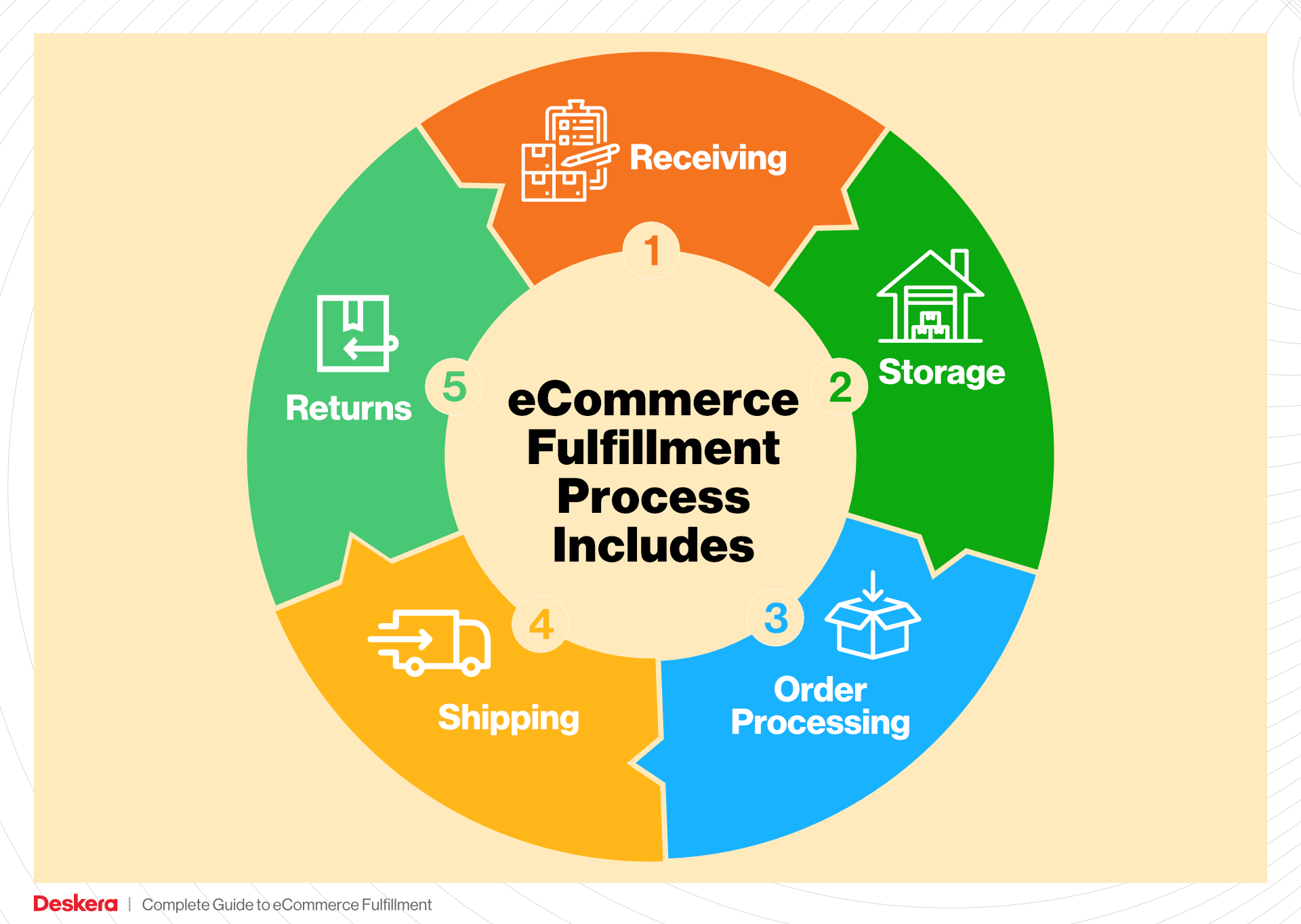
Finally, pricing is a vital consideration when evaluating fulfillment options. We will break down the costs associated with different fulfillment models, helping you to budget effectively and maximize your profit margins.
The ultimate goal of this guide is to empower you with the knowledge to make smart, strategic decisions about your logistics. By mastering e-commerce fulfillment, you can focus on what you do best—growing your business and delighting your customers. Let’s dive into the world of e-commerce fulfillment and unlock the potential of efficient logistics for your brand.
What You’ll Learn In This Guide
- What is E-commerce Fulfillment? An Introduction for Growing Businesses
- The Order Fulfillment Process: From ‘Buy’ Button to Customer’s Door
- Comparing Fulfillment Models: In-House vs. 3PL vs. Dropshipping
- A Deep Dive into Amazon FBA: Pros, Cons, and Who It’s For
- Core Services Offered by Fulfillment Centers
- How to Choose a Fulfillment Partner: A 6-Point Checklist
- Understanding Fulfillment Pricing: A Breakdown of Common Fees
- Frequently Asked Questions (FAQs) about Fulfillment
- Conclusion: Is Outsourcing Fulfillment the Right Move for Your Business?
- Important Disclaimer
The Order Fulfillment Process: From ‘Buy’ Button to Customer’s Door
1. Receiving Inventory
The first step in the order fulfillment process is receiving inventory. When products arrive at the fulfillment center, they are unloaded and checked against purchase orders to ensure accuracy. This involves scanning each item and verifying that the correct quantities and product types have been received.
Importance: This step is critical as it sets the foundation for an efficient fulfillment process. Any discrepancies at this stage can lead to stockouts or delays in order processing, which can ultimately impact customer satisfaction.
Key Term: SKU (Stock Keeping Unit) – A unique identifier assigned to each product that helps in tracking inventory levels and managing stock efficiently.
2. Warehouse Storage
Once the inventory is received and verified, it is then stored in the warehouse. This involves placing items in designated storage locations, which can vary from shelving units to pallets, depending on the size and type of products. Advanced fulfillment centers, like Amazon’s MCO1 facility, utilize technology such as automated storage and retrieval systems to optimize space and improve efficiency.
Importance: Proper warehouse storage is crucial for minimizing retrieval times during the picking process. Efficient storage solutions can reduce the time it takes for employees or robots to locate and access items, which directly impacts the speed of order fulfillment.
Key Term: ABC Analysis – A method of categorizing inventory based on its importance, which helps in determining storage locations and managing stock levels effectively.
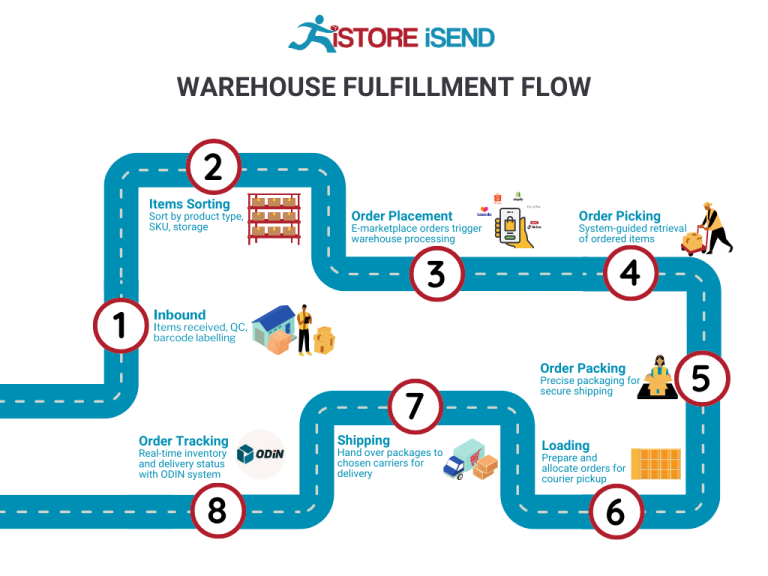
3. Order Picking
The next step is order picking, where items are selected from their storage locations to fulfill customer orders. This process can be manual, where employees use pick lists to gather products, or automated, where robots are deployed to retrieve items. The choice of method often depends on the volume of orders and the technology available at the fulfillment center.
Importance: Efficient order picking is vital for ensuring that the right products are delivered to customers on time. Mistakes in this phase can lead to returns, increased shipping costs, and dissatisfied customers.
Key Term: Pick Lists – Documents or digital records that detail the items and quantities required for each order, guiding the picker through the warehouse.
4. Order Packing
After items are picked, they are taken to the packing area, where they are prepared for shipment. This involves checking the items for accuracy, packing them securely in appropriate boxes, and labeling them for delivery. Advanced fulfillment centers often use packing stations equipped with technology that can weigh packages and recommend the best box size to minimize shipping costs.
Importance: Order packing is essential for protecting products during transit and ensuring that they arrive in perfect condition. Proper packing also helps reduce shipping costs by optimizing box sizes and weights.
Key Term: Packing Slip – A document included in the package that lists the items being shipped, providing transparency and aiding in the return process if necessary.
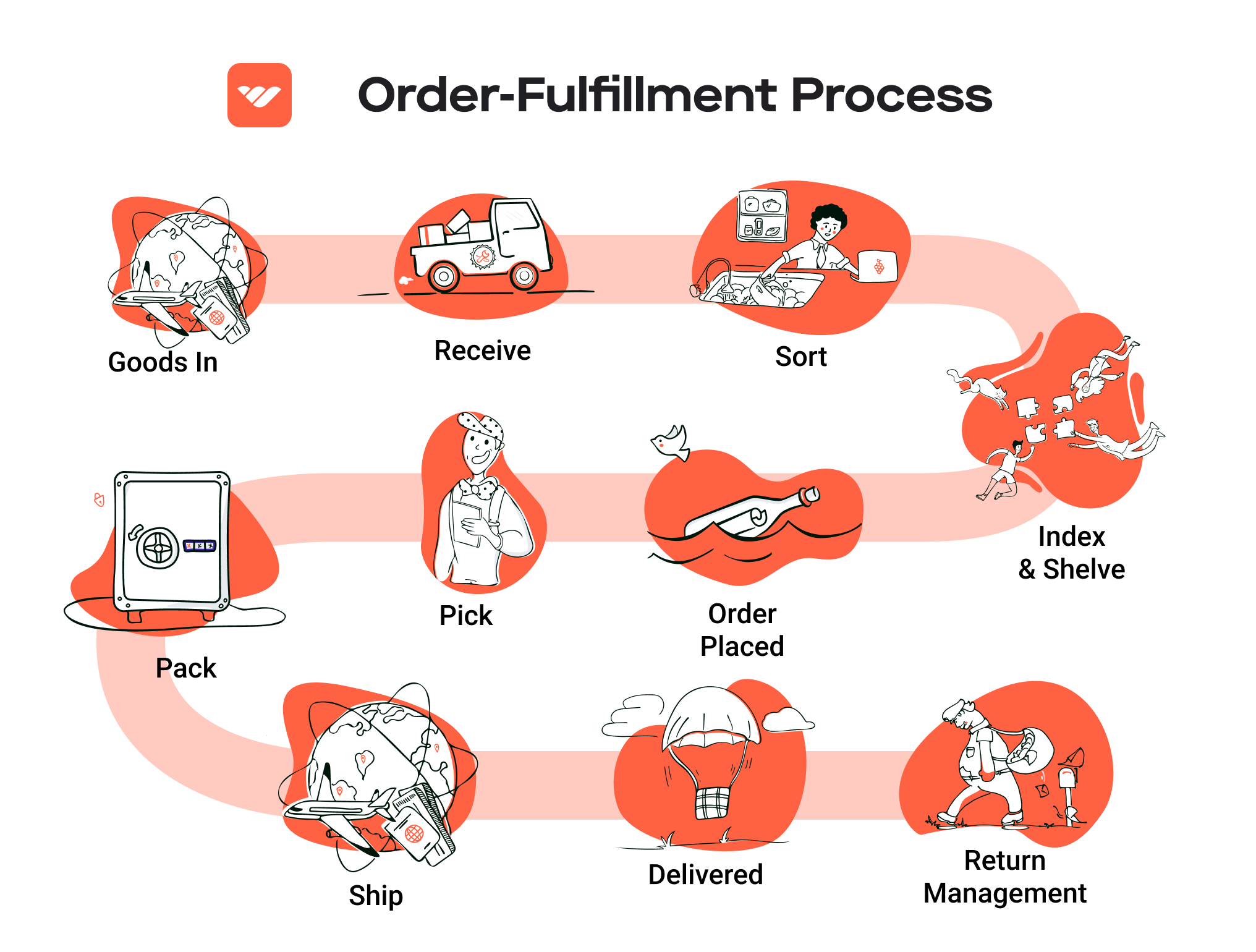
5. Shipping & Delivery
The final step in the order fulfillment process is shipping and delivery. Once packages are packed and labeled, they are handed over to shipping carriers for transportation to the customer’s location. Fulfillment centers like Amazon MCO1 have strategic partnerships with multiple carriers to ensure fast and reliable delivery options, including same-day and next-day services.
Importance: This step is critical as it represents the culmination of the entire fulfillment process. Timely and accurate delivery is key to customer satisfaction and can significantly influence repeat purchases.
Key Term: Last-Mile Delivery – The final leg of the shipping process where the package is delivered from a distribution center to the end customer, often considered the most critical and costly part of the shipping journey.
By understanding and optimizing each of these steps, e-commerce businesses can enhance their order fulfillment processes, improve operational efficiency, and ultimately boost customer satisfaction. As you scale your business, investing in technology and best practices for each of these stages will help you meet increasing customer expectations and maintain a competitive edge in the market.
Comparing Fulfillment Models: In-House vs. 3PL vs. Dropshipping
Fulfillment Models Comparison
| Model | Who Handles Inventory | Best For (Business Stage) | Key Advantage | Key Disadvantage |
|---|---|---|---|---|
| In-House Fulfillment | Business itself | Established businesses | Full control over inventory and operations | High upfront costs and operational complexity |
| Third-Party Logistics (3PL) | External logistics provider | Growing businesses | Scalable operations and reduced capital risk | Less control over inventory and potential delays |
| Dropshipping | Supplier | Startups and small businesses | Low overhead and no inventory management required | Lower profit margins and reliance on supplier speed |
In-House Fulfillment
In-house fulfillment involves managing the entire logistics process internally, including inventory storage, order processing, packing, and shipping. This model is typically adopted by established businesses with sufficient resources and infrastructure to handle logistics independently. The primary advantage of in-house fulfillment is the complete control it offers over inventory management and customer experience. Companies can ensure that products are stored, handled, and shipped according to their specific standards, which can enhance brand reputation and customer satisfaction.
However, the disadvantages are significant. In-house fulfillment requires substantial investment in warehousing, staffing, technology, and logistics management. This model can lead to operational complexities, especially as order volumes increase. Businesses may find it challenging to scale operations efficiently without incurring additional costs. Moreover, handling logistics internally can distract from core business activities, such as product development and marketing.
Third-Party Logistics (3PL)
Third-party logistics (3PL) providers offer businesses a way to outsource their fulfillment processes. In this model, a third-party company takes over various logistics functions, including warehousing, inventory management, order processing, and shipping. This approach is especially beneficial for growing businesses that are looking to scale operations without the burden of managing logistics themselves.
The key advantage of using a 3PL provider is scalability. As businesses experience growth, 3PLs can adjust operations to meet increasing demand without the need for significant capital investment in infrastructure. Furthermore, 3PL providers often have established relationships with shipping carriers, which can lead to better shipping rates and faster delivery times. However, the downside is that businesses lose some control over their inventory and fulfillment processes. This can lead to potential delays or issues in customer service, especially if the 3PL provider does not meet the business’s quality standards.
Dropshipping
Dropshipping is a fulfillment model where the retailer does not keep products in stock. Instead, when a retailer sells a product, they purchase the item from a third party (usually a wholesaler or manufacturer) who then ships it directly to the customer. This model is particularly attractive to startups and small businesses because it eliminates the need for inventory management and reduces upfront costs.
The primary advantage of dropshipping is the low overhead. Retailers do not need to invest in inventory or warehouse space, allowing them to focus on marketing and sales. This model is also flexible, enabling businesses to test new products without financial risk. However, dropshipping comes with its challenges. Profit margins can be lower compared to traditional retail models, as suppliers often charge higher prices for the convenience of dropshipping. Additionally, retailers are reliant on their suppliers for order fulfillment, which can lead to delays and inconsistencies in product quality and shipping times.
Conclusion
Choosing the right fulfillment model is crucial for e-commerce businesses aiming to scale effectively. In-house fulfillment offers control and brand integrity but requires significant investment and operational focus. Third-party logistics provide scalability and efficiency, but at the cost of some control. Dropshipping presents an accessible entry point for new businesses, yet it carries risks related to margins and supplier reliability. Each model has its place depending on the business stage and strategic goals, and understanding these differences can help business owners make informed decisions that align with their growth objectives.
A Deep Dive into Amazon FBA: Pros, Cons, and Who It’s For
Understanding Fulfillment by Amazon (FBA)
Fulfillment by Amazon (FBA) is a service offered by Amazon that allows sellers to store their products in Amazon’s fulfillment centers. Amazon then takes care of storage, packaging, and shipping, as well as customer service and returns. This service is designed to simplify the logistics for e-commerce businesses, allowing them to focus on other aspects of their operations, such as product development and marketing.
When a customer orders a product from a seller using FBA, Amazon handles the entire transaction process. This includes picking the product from the warehouse, packing it, and shipping it directly to the customer. Sellers can also benefit from Amazon’s robust infrastructure, including its advanced logistics network and customer service.
How FBA Works
-
Setup: Sellers need to create an Amazon Seller account and enroll in the FBA program. This involves listing products that they wish to fulfill through Amazon.
-
Shipping Inventory: Sellers send their products to Amazon’s fulfillment centers. The inventory is tracked and stored in Amazon’s warehouses, which can be located across various regions, including the newly established facility at 12340 Boggy Creek Rd, Orlando, FL.
-
Order Fulfillment: When a customer places an order for a product fulfilled by Amazon, the order is automatically routed to Amazon’s fulfillment center where the product is stored. The item is picked, packed, and shipped to the customer.
-
Customer Service: Amazon also manages customer service and returns for FBA orders. This allows sellers to provide a high level of service without having to manage these aspects themselves.
-
Fees: Sellers are charged fees for using FBA. These fees can vary based on the size and weight of the items, as well as other services utilized.
Pros of Using FBA
-
Prime Eligibility: Products fulfilled by Amazon are eligible for Amazon Prime, which can significantly increase visibility and sales. Prime members often prefer products that qualify for fast, free shipping.
-
Customer Trust: Leveraging Amazon’s brand and reputation can enhance customer trust. Buyers are often more willing to purchase products that come with the Amazon guarantee, knowing they have access to reliable customer service and return options.
-
Multi-Channel Fulfillment: FBA allows sellers to use Amazon’s fulfillment services for orders placed on other platforms, such as their own websites or eBay. This can streamline operations and reduce the complexity of managing multiple inventory sources.
-
Time Savings: By outsourcing logistics to Amazon, sellers can focus on other critical business areas like marketing, product sourcing, and customer engagement.
-
Access to Advanced Technology: Amazon’s fulfillment centers utilize sophisticated technology and processes for inventory management, which can help optimize storage and shipping efficiency.
Cons of Using FBA
-
High Fees: FBA involves various fees, including storage fees for items kept in Amazon warehouses and fulfillment fees for each order processed. These costs can add up quickly, especially for small businesses with tight margins.
-
Strict Inventory Rules: Amazon has stringent guidelines regarding inventory management. Sellers must comply with specific requirements, such as labeling and packaging standards, which can be time-consuming and complex.
-
Commingling Risks: FBA products are often commingled, meaning that inventory from different sellers can be stored together. This can lead to issues if a seller receives negative feedback due to problems with a product that they did not sell.
-
Limited Control: When using FBA, sellers have limited control over the fulfillment process. This can be problematic if there are issues with inventory management or shipping times, as sellers must rely on Amazon to resolve these.
-
Long-Term Storage Fees: If products remain unsold for an extended period, sellers incur additional long-term storage fees. This can pressure sellers to reduce prices or find other ways to move inventory.
Who is FBA Best For?
FBA can be an excellent option for various types of e-commerce businesses:
-
Startups and Small Businesses: New sellers looking to establish their presence on Amazon can benefit from the logistical support and customer trust associated with FBA.
-
Businesses with High Sales Volume: Sellers who move a high volume of products can take advantage of the efficiencies offered by FBA, which can lead to increased profitability despite higher fees.
-
Sellers with Limited Resources: E-commerce businesses that lack the infrastructure or resources to manage logistics effectively can leverage FBA to streamline their operations.
-
Brands Seeking Prime Membership: Companies that want to access the lucrative Prime market can greatly benefit from FBA, as it allows them to offer Prime shipping to their customers.
-
Multi-Channel Sellers: Businesses that sell on multiple platforms can use FBA to simplify their fulfillment process and improve their overall efficiency.
In conclusion, FBA is a powerful tool for e-commerce businesses looking to scale their operations and improve customer satisfaction. While it comes with its own set of challenges, the benefits often outweigh the drawbacks for many sellers, particularly those who are just starting or those who want to expand their reach without the complexities of managing logistics on their own. By carefully weighing the pros and cons, businesses can determine if FBA aligns with their operational goals and growth strategies.
Core Services Offered by Fulfillment Centers
Inventory Management & Warehousing
Effective inventory management is the backbone of any successful e-commerce operation. Fulfillment centers provide businesses with the capability to store and manage their products efficiently. This service includes receiving inventory, tracking stock levels, managing replenishment, and organizing storage to maximize space utilization.
By leveraging advanced inventory management systems, fulfillment centers can offer real-time visibility into stock levels, helping businesses avoid stockouts and overstock situations. For e-commerce entrepreneurs, this means they can maintain optimal inventory levels without the burden of managing a warehouse themselves.
The benefits are manifold:
– Cost Efficiency: Outsourcing warehousing reduces overhead costs associated with owning and operating a storage facility.
– Scalability: As businesses grow, fulfillment centers can easily adapt to increased inventory needs without the hassle of relocating or expanding warehouse space.
– Focus on Core Activities: With inventory management handled by professionals, e-commerce businesses can concentrate on marketing, product development, and customer service, thus driving growth.
Pick and Pack Services
Pick and pack services are essential for fulfilling customer orders accurately and efficiently. This process involves selecting items from the warehouse shelves (picking) and packing them securely for shipment (packing). Fulfillment centers utilize sophisticated technology, such as barcode scanning and automated picking systems, to streamline these operations.
For e-commerce businesses, the advantages of outsourcing pick and pack services are significant:
– Speed and Accuracy: Professional fulfillment centers are equipped to process orders quickly while minimizing errors. This efficiency leads to faster delivery times and enhances customer satisfaction.
– Flexibility: Businesses can easily adjust their order fulfillment processes based on seasonal demand fluctuations or promotional campaigns without investing in additional labor or infrastructure.
– Quality Control: Fulfillment centers often implement stringent quality control measures, ensuring that the correct items are shipped in good condition, which reduces return rates and increases customer trust.
Kitting and Assembly
Kitting and assembly services involve bundling individual products into a single package or assembling components into a finished product. This is particularly useful for businesses that sell products that need to be combined before shipment, such as promotional kits, subscription boxes, or complex products requiring assembly.
By utilizing kitting and assembly services, e-commerce businesses can enjoy numerous benefits:
– Enhanced Customer Experience: By providing ready-to-use products, businesses can improve customer satisfaction. For example, a subscription box service can delight customers by delivering a curated selection of items without additional assembly on their part.
– Cost Savings: Outsourcing kitting and assembly reduces the need for in-house labor and resources, allowing businesses to allocate those funds towards growth strategies such as marketing or product development.
– Streamlined Operations: Fulfillment centers specializing in kitting and assembly can manage these processes more efficiently than most businesses could in-house, allowing for quicker turnaround times and reduced complexity in logistics.
Returns Management (Reverse Logistics)
In the world of e-commerce, managing returns is as crucial as the initial sale. Returns management, or reverse logistics, refers to the process of handling returned merchandise, including receiving, inspecting, restocking, or disposing of items. Fulfillment centers can streamline this process, which is often a pain point for many online retailers.
The benefits of effective returns management through fulfillment centers include:
– Simplified Processes: Outsourcing returns management allows businesses to focus on core operations while ensuring that returns are processed efficiently and accurately.
– Improved Customer Retention: A well-managed returns process enhances customer satisfaction, as customers are more likely to shop again if they know their returns will be handled smoothly.
– Data Insights: Fulfillment centers can provide valuable data on return trends, helping businesses understand why products are returned and allowing them to make informed decisions regarding product quality, marketing strategies, and inventory management.
In conclusion, partnering with a fulfillment center offers e-commerce businesses a comprehensive suite of services that not only streamline operations but also enhance customer satisfaction. By leveraging these core services—inventory management and warehousing, pick and pack services, kitting and assembly, and returns management—business owners can focus on scaling their operations and driving growth in an increasingly competitive marketplace.
How to Choose a Fulfillment Partner: A 6-Point Checklist
Location & Warehouse Network
Why It’s Important:
The location of your fulfillment partner’s warehouses can significantly affect shipping times, costs, and overall customer satisfaction. A partner with strategically placed fulfillment centers can help you reach your customers faster and reduce shipping expenses.
Questions to Ask:
– Where are your fulfillment centers located, and how does this align with my target market?
– How does your warehouse network support multi-channel fulfillment (e.g., Amazon, eBay, direct-to-consumer)?
– Can you provide insights into your shipping rates and transit times for various regions?
Technology & Integrations
Why It’s Important:
In today’s fast-paced e-commerce landscape, technology is crucial for operational efficiency. A fulfillment partner with advanced technology can offer real-time inventory management, tracking, and reporting, which can help you make informed business decisions.
Questions to Ask:
– What technology platform do you use for order management, and how does it integrate with my existing systems (e.g., ERP, e-commerce platform)?
– Do you provide real-time tracking and reporting features? If so, can I customize the reports?
– How do you ensure data security and compliance with relevant regulations?
Specializations (e.g., cold storage, oversized items)
Why It’s Important:
Not all fulfillment partners are equipped to handle specialized products. If your business deals in perishable goods, oversized items, or hazardous materials, it’s essential to choose a partner with the right capabilities.
Questions to Ask:
– What types of specialized services do you offer (e.g., cold storage, kitting, or assembly)?
– Do you have experience managing products similar to mine? Can you provide examples?
– How do you ensure compliance with regulations specific to my product category?
Scalability & Capacity
Why It’s Important:
As your business grows, your fulfillment needs will likely evolve. A partner should have the capacity to scale operations seamlessly to accommodate increased order volumes without compromising service quality.
Questions to Ask:
– What is your current capacity, and how quickly can you scale operations if my order volume increases?
– Do you have a plan in place for peak seasons or unexpected surges in demand?
– How do you handle inventory management during periods of rapid growth?
Pricing and Contracts
Why It’s Important:
Understanding the pricing structure and contractual obligations is vital to avoid unexpected costs. Transparency in pricing can help you budget effectively and make informed decisions about your fulfillment strategy.
Questions to Ask:
– What is your pricing model (e.g., per order, per item, monthly fee), and what factors can influence these costs?
– Are there any additional fees (e.g., storage, pick and pack, returns) that I should be aware of?
– What are the terms of the contract, and what is the process for terminating or renegotiating the agreement?
Customer Support & Reviews
Why It’s Important:
Reliable customer support is crucial for resolving issues quickly and maintaining operational continuity. Additionally, researching reviews can provide insight into the partner’s reliability and service quality.
Questions to Ask:
– What level of customer support do you provide, and how can I reach you during business hours?
– Can you provide references or case studies from businesses similar to mine?
– How do you handle customer complaints or issues that arise during the fulfillment process?
In conclusion, choosing the right fulfillment partner is a critical decision that can significantly impact your e-commerce business. By utilizing this checklist, you can make an informed choice that aligns with your operational needs and growth ambitions. Focus on establishing a partnership that not only meets your current requirements but also supports your long-term goals.
Understanding Fulfillment Pricing: A Breakdown of Common Fees
Initial Setup Fees
When engaging with a fulfillment center, the initial setup fees represent the costs associated with onboarding your products into their system. This can include administrative fees for account creation, software integration, and initial inventory assessments. Typically, these fees can range from a few hundred to several thousand dollars, depending on the complexity of your operations and the specific requirements of the fulfillment center.
The calculation of initial setup fees often depends on factors such as the size of your product catalog, the level of customization needed for your account, and any specific technology integrations required (like linking your e-commerce platform to their inventory management system). It’s crucial to understand what these fees cover and if there are any ongoing costs associated with maintaining your account.
Receiving Fees
Receiving fees are charged when your products arrive at the fulfillment center. This fee covers the labor and resources needed to unload, inspect, and catalog your inventory. Typically calculated on a per-unit basis, these fees can vary widely based on the size, weight, and complexity of the products being received.
For example, receiving small items might incur a lower fee compared to larger or bulkier items that require more handling. Additionally, if your products require special handling (like fragile items), this may increase the receiving fee. Understanding the specifics of how these fees are applied can help you budget more accurately for your fulfillment expenses.
Storage Fees (per pallet/bin)
Once your products are stored in the fulfillment center, storage fees come into play. These fees are generally charged on a monthly basis and can be calculated based on the amount of space your inventory occupies, often measured in pallets or bins.
The average storage fee can range from $10 to $30 per pallet per month, but this can vary based on location and demand. Additionally, some fulfillment centers may have tiered pricing based on the total volume of inventory you store. It’s important to evaluate how your inventory turnover rates may affect your storage costs, as higher turnover can reduce the impact of these fees.
Pick & Pack Fees (per item/order)
Pick & pack fees are incurred when the fulfillment center picks items from storage and prepares them for shipment. This fee is typically calculated on a per-item or per-order basis. For instance, the fee may be lower for orders with multiple items picked together versus individual item orders.
These fees can range from $1 to $5 per item, depending on the complexity of the picking process. Factors that may affect this fee include the number of items in an order, the time required to gather and package them, and any special packing requirements (like branded packaging or gift wrapping). Understanding these fees can help you optimize your product offerings and order sizes to minimize costs.
Shipping Fees
Shipping fees are the costs associated with delivering your products to customers. These fees can vary based on several factors, including the weight and dimensions of the package, the shipping method selected (standard, expedited, etc.), and the destination.
Fulfillment centers often negotiate shipping rates with carriers, which can lead to lower costs for you, but it’s important to clarify how these shipping fees are calculated. Some centers may charge a flat fee per shipment, while others may pass through the actual carrier rates. Additionally, keep an eye out for any minimum shipping charges or surcharges that could apply based on shipping zones.
Tips for Getting an Accurate Quote
To ensure you receive an accurate quote for fulfillment services, consider the following tips:
-
Provide Detailed Information: Be as specific as possible about your product types, sizes, weights, and expected order volumes. This information will help the fulfillment center assess your needs accurately.
-
Ask About All Fees: Inquire about all potential fees, including hidden costs that may not be initially mentioned, such as long-term storage fees or special handling fees.
-
Review Contracts Carefully: Ensure you understand the terms of service and pricing structure outlined in the contract. Look for clauses regarding fee increases or changes in service.
-
Consider Seasonal Fluctuations: Discuss how seasonal fluctuations in order volume may impact pricing, especially for storage and shipping costs.
-
Negotiate Terms: Don’t hesitate to negotiate terms based on your expected volume and the potential for a long-term partnership. Fulfillment centers may offer discounts for higher volumes or longer contracts.
By understanding the various fees associated with fulfillment services and following these tips, you can better prepare your business for the costs involved and optimize your logistics strategy.
Frequently Asked Questions (FAQs) about Fulfillment
1. What is the Amazon Fulfillment Center MCO1 located at Boggy Creek Road in Orlando, FL?
The Amazon Fulfillment Center MCO1 is a high-tech logistics facility situated at 12340 Boggy Creek Road, Orlando, FL. Spanning 850,000 square feet, with potential for expansion to 2.4 million square feet, this center plays a critical role in processing and shipping millions of items to customers efficiently.
2. How does the fulfillment process at Amazon MCO1 work?
At Amazon MCO1, products are stored, packed, and shipped from the facility to customers. When an order is placed, items are retrieved from inventory using advanced robotics and technology, packed into boxes, and prepared for shipment. This process is designed to ensure quick delivery times, especially for Prime members.
3. What are the operational hours of the Amazon Fulfillment Center MCO1?
The Amazon Fulfillment Center MCO1 operates 24 hours a day, seven days a week. This continuous operation allows for the rapid processing of orders and quick turnaround times for shipments.
4. What is the difference between a warehouse and a fulfillment center?
A warehouse is primarily used for storage of goods, while a fulfillment center focuses on processing and shipping orders directly to customers. Fulfillment centers are equipped with technology and systems designed to handle the logistics of order fulfillment, including picking, packing, and shipping.
5. What is a third-party logistics provider (3PL)?
A third-party logistics provider (3PL) is a company that offers logistics services to businesses, including warehousing, fulfillment, and distribution. They manage the supply chain process, allowing businesses to focus on their core operations while leveraging the 3PL’s expertise and infrastructure.
6. How much do fulfillment services cost?
Fulfillment service costs can vary based on several factors, including the volume of orders, storage needs, and specific services required (like packing or special handling). Typically, costs can range from $2 to $5 per order, plus storage fees that can range from $0.10 to $0.50 per cubic foot per month. It’s advisable for businesses to evaluate their specific needs to get accurate pricing.
7. What types of products can be fulfilled from the Amazon MCO1 center?
Amazon MCO1 can handle a wide range of products, including electronics, clothing, household items, and more. The facility is designed to accommodate items of various sizes, though it specializes in shipping products smaller than a conventional microwave alongside robotic assistance.
8. Can I visit the Amazon Fulfillment Center MCO1?
Yes, Amazon offers in-person tours of the MCO1 fulfillment center. These tours provide insight into the fulfillment process and the technology used. Visitors must register in advance and adhere to safety guidelines, including appropriate attire.
9. What technologies are used in the Amazon MCO1 fulfillment center?
The Amazon MCO1 center utilizes advanced robotics and automation technologies to streamline the fulfillment process. This includes robotic systems for sorting and transporting items, as well as sophisticated inventory management systems to track stock levels in real time.
10. How can I partner with Amazon for fulfillment services?
To partner with Amazon for fulfillment services, businesses can explore Amazon’s Fulfillment by Amazon (FBA) program. This program allows sellers to store their products in Amazon’s fulfillment centers, where Amazon takes care of storage, packing, and shipping. Interested businesses can sign up through the Amazon Seller Central portal to get started.
Conclusion: Is Outsourcing Fulfillment the Right Move for Your Business?
Key Benefits of Outsourcing Fulfillment
Outsourcing fulfillment can significantly enhance your e-commerce operations, especially if you’re looking to scale. One of the primary advantages is time savings. By delegating logistics and inventory management to a dedicated partner, you can focus on core business activities such as product development, marketing, and customer engagement. This shift not only improves operational efficiency but also allows you to respond more quickly to market demands.
Scalability is another crucial benefit. A fulfillment partner can accommodate fluctuations in order volume, whether during seasonal peaks or unexpected surges in demand. With facilities like the Amazon Fulfillment Center at MCO1 in Orlando, which boasts advanced technology and extensive capacity, you can ensure that your business remains agile and responsive without the burden of managing additional warehousing and staffing.
Moreover, these partners bring expertise in logistics, which can streamline your supply chain. They understand the intricacies of shipping, customs, and returns management, ensuring that your products reach customers efficiently while adhering to compliance standards. This expertise can translate into cost savings and improved customer satisfaction, as faster and more reliable deliveries enhance the overall shopping experience.
Choosing the Right Partner for Growth
However, the success of outsourcing fulfillment hinges on selecting the right partner. Consider factors such as location, technology, and customer service capabilities. A well-aligned partner can provide not just fulfillment services but also strategic insights that support your long-term growth.
Call to Action
As you evaluate your current operations, take the time to audit your shipping processes. Analyze your fulfillment costs, delivery times, and customer feedback. This assessment will help determine if partnering with a fulfillment center like the Amazon MCO1 is the right next step for your business. By making informed decisions now, you can set the stage for sustainable growth and operational excellence in the future.
Important Disclaimer
⚠️ Important Disclaimer
The information in this guide is for educational purposes. Fulfillment services, pricing, and platform features change frequently. Always conduct your own due diligence and consult with providers directly before making business decisions.
